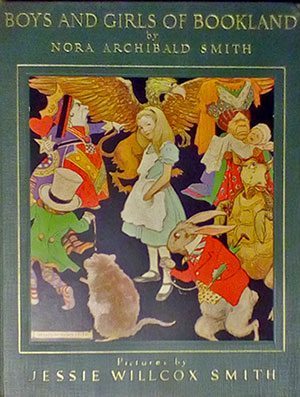 This is how book collecting goes. You see something that piques your curiosity. You wonder: “Why did this book get published?” “Who would have bought this book?” “On whose shelves did this book rest and why did they let it go?” “Was it a gift, never opened, or was it cherished and read over and over again?”
This is how book collecting goes. You see something that piques your curiosity. You wonder: “Why did this book get published?” “Who would have bought this book?” “On whose shelves did this book rest and why did they let it go?” “Was it a gift, never opened, or was it cherished and read over and over again?”
Sometimes you’re curious about the text or the illustrations or the binding or the publisher.
When I first began collecting books, satisfying my curiosity was hit or miss. I would go to the library and look up some of the things I wondered about in the Reader’s Guide to Periodical Literature or in the card catalogue (I know I’m dating myself, but that’s the point). Usually, I had to keep wondering.
Book collecting today is entirely different. Many of the antiquarian bookstores I frequented are gone because it became too expensive to maintain a physical store. They sell on the internet where one entirely misses the smell and randomness and happy accidents of book collecting. And yet I have access to used bookstores across the country. One comes to appreciate the buyers in these stores, their particular tastes.
A couple of my favorites? Cattermole 20th Century Children’s Books in Ohio. The Hermitage Bookshop in Denver. Old Children’s Books in Oregon. Do you have a favorite? Please share in the comments.
Sometime last year, I purchased Boys and Girls of Bookland from Bob Topp at The Hermitage Bookshop. I did this because it was illustrated by Jessie Wilcox Smith and I hadn’t ever heard of the book. I admire Miss Smith’s work a lot. And I admire the story of her life.
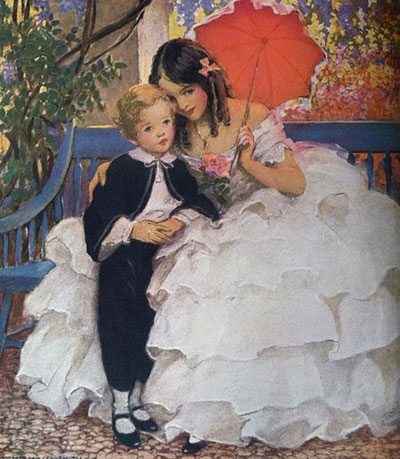
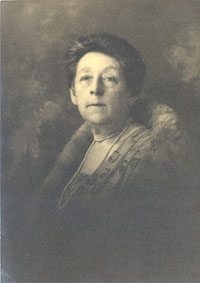
The book is written by Nora Archibald Smith. I’d never heard of her before. Because of the internet, I quickly discovered she was Kate Douglas Wiggin’s sister. You remember Ms. Wiggin: Rebecca of Sunnybrook Farm. I also learned that the two sisters were instrumental in founding the Kindergarten movement in San Francisco in 1873. They wrote 15 books together. I’ll have to hunt for more about this author.
The book’s copyright is with the Cosmopolitan Book Corporation which, with a little digging, I learned was owned by William Randolph Hearst. Why would he publish this book?
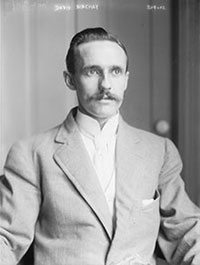
The publisher of this book is David MacKay. I learned that he was born in Scotland in 1860. He immigrated to the USA in 1871, when he was 11. At age 13, he started working for J.B. Lippincott, learning the bookselling trade. A rival publisher, Rees Welsh, offered him a job. During his tenure, he published Walt Whitman’s Leaves of Grass before he was 21, even though the attorney-general of Massachusetts didn’t want it published for its “alleged immorality.” At age 22, MacKay opened his own publishing company, eponymously named. Will I be able to find out more about him?
You see, the author wrote roughly nine pages each about famous books such as Little Women, The Jungle Book, David Copperfield, Jackanapes, and more. They’re summaries of the stories, hoping you will read the full book. I guess you could say they’re lengthy booktalks in writing. And Jessie Wilcox Smith did a painting for each story in full color. What an interesting format. Were other books like this published?
I even searched online to find the name of the woman who was given this book as a gift, Susan Class House, from Uncle Thad and Auntie “B” Lawrence. I would like to know more about their lives.
There are often objects inside a book. This one did not disappoint. I found a plastic bookmark, a Yahtzee® scorecard with a 1996 copyright date, and a “Thank you!” card from Bob Topp.
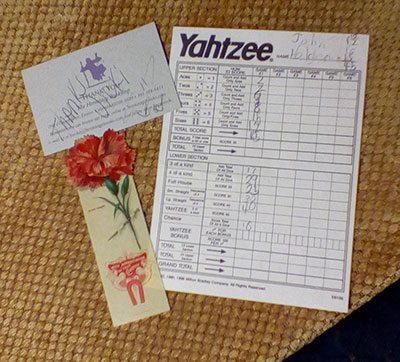
Book collecting isn’t just buying a book to read the story. It’s about discovering the stories that swirl around the book.

I still love to visit http://brynmawrbookstore.com/ when in Cambridge! Still home to many bookstores but not as many as there once were.
Thanks for the suggestion, Cathy. We’re planning to be in that area this summer … we’ll make it a point to visit the store.
It IS fascinating to think of the life a used book may have had before it reached us. What an intriguing collection of items found inside this one!